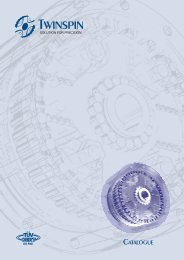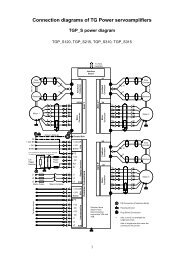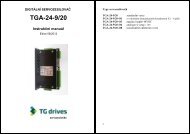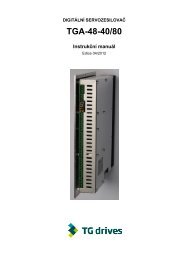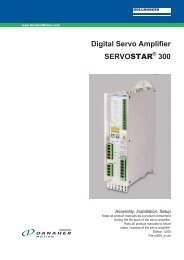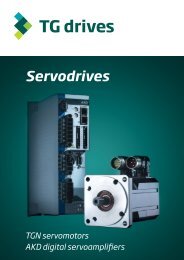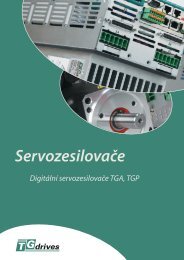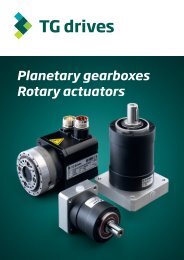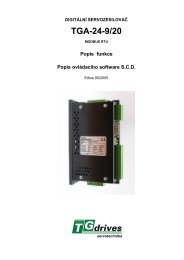Table of Contents - TG Drives
Table of Contents - TG Drives
Table of Contents - TG Drives
Create successful ePaper yourself
Turn your PDF publications into a flip-book with our unique Google optimized e-Paper software.
EXTENDED REGISTER GROUPS<br />
LAN1, Local area network 1<br />
_ x x x _ _ _ _ x = TSEG2 1-7,<br />
time segment after the sampling point.<br />
_ _ _ _ x x x x x = TSEG1 2-15,<br />
time segment before the sampling point.<br />
Bit No. Description<br />
7 6 5 4 3 2 1 0 Bit Timing Register 1.<br />
x x _ _ _ _ _ _ SJW 0-3 Sync. jump width.<br />
_ _ x x x x x x BRP 0-63 Baud Rate prescaler.<br />
Group.Member Member<br />
No.<br />
Range Ability<br />
LAN1.LowProt 3 0..2 R<br />
Low level communication protocol. This member represents<br />
the physical and data link layers <strong>of</strong> the OSI reference model.<br />
The CAN low level protocol features:<br />
Bit wise Contention, mechanism to resolve collisions based on<br />
the priority <strong>of</strong> the message id number.<br />
# Standard Data and Remote frames, 11 bit id (CAN 2.0 part A).<br />
# Extended Data and Remote frames, 29 bit id (CAN 2.0 part B).<br />
# 12 ”Live” Message objects. (CAN 2.0 part B).<br />
# 0 to 8 byte data per message.<br />
# Programmable bit rate (higher bit rate for shorter distances).<br />
(Note. bit rate is not the same as throughput).<br />
This member is also used to inform an application program<br />
about the presence <strong>of</strong> the LAN.<br />
0 = Not available<br />
1 = Standard, CAN specification 2.0 part A is supported.<br />
2 = Standard and Extended, CAN specification 2.0 part B is<br />
supported.<br />
The Standard CAN spec is a subset <strong>of</strong> the Extended spec.<br />
The CAN protocol uses a multi-master (contention based) bus<br />
configuration for transfer <strong>of</strong> ”communication objects” between<br />
nodes <strong>of</strong> the network. This multi-master node is also referred<br />
to as CSMA/CR or Carrier Sense, Multiple Access, with<br />
Collision Resolution.<br />
As defined in ISO/DIS 11898 Road vehicles - Interchange <strong>of</strong><br />
digital information - Controller area network (CAN) for highspeed<br />
communication.<br />
LAN1.HighProt 4 0 R<br />
High level communication protocol. This member indicate,<br />
what protocol set are used for the layers that are not defined in<br />
LAN.LowProt.0 = No high<br />
level protocol implemented.<br />
User's Manual 5.1 Inmotion Technologies AB<br />
Doc. No.9032 0027 01 (B), Rev. 11.07.2001<br />
145



